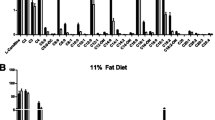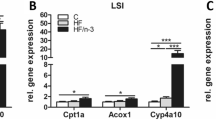Abstract
Daily intake of conjugated linoleic acid (CLA) has been shown to reduce body fat accumulation and to increase body metabolism; this latter effect has been often associated with the up-regulation of uncoupling proteins (UCPs). Here we addressed the effects of a CLA-supplemented murine diet (~2 % CLA mixture, cis-9, trans-10 and trans-10, cis-12 isomers; 45 % of each isomer on alternating days) on mitochondrial energetics, UCP2 expression/activity in the liver and other associated morphological and functional parameters, in C57BL/6 mice. Diet supplementation with CLA reduced both lipid accumulation in adipose tissues and triacylglycerol plasma levels, but did not augment hepatic lipid storage. Livers of mice fed a diet supplemented with CLA showed high UCP2 mRNA levels and the isolated hepatic mitochondria showed indications of UCP activity: in the presence of guanosine diphosphate, the higher stimulation of respiration promoted by linoleic acid in mitochondria from the CLA mice was almost completely reduced to the level of the stimulation from the control mice. Despite the increased generation of reactive oxygen species through oxi-reduction reactions involving NAD+/NADH in the Krebs cycle, no oxidative stress was observed in the liver. In addition, in the absence of free fatty acids, basal respiration rates and the phosphorylating efficiency of mitochondria were preserved. These results indicate a beneficial and secure dose of CLA for diet supplementation in mice, which induces UCP2 overexpression and UCP activity in mitochondria while preserving the lipid composition and redox state of the liver.
Similar content being viewed by others
References
Alberici LC, Oliveira HC, Patrício PR, Kowaltowski AJ, Vercesi AE (2006) Hyperlipidemic mice present enhanced catabolism and higher mitochondrial ATP-sensitive K + channel activity. Gastroenterology 131:1228–1234
Alberici RM, Simas RC, Sanvido GB, Romão W, Lalli PM, Benassi M et al (2010) Ambient mass spectrometry: bringing MS into the real world. Anal Bioanal Chem 398:265–294
Alberici LC, Oliveira HC, Catharino RR, Vercesi AE, Eberlin MN, Alberici RM (2011) Distinct hepatic lipid profile of hypertriglyceridemic mice determined by easy ambient sonic-spray ionization mass spectrometry. Anal Bioanal Chem 401:1651–1659
Azain MJ, Hausman DB, Sisk MB, Flatt WP, Jewell DE (2000) Dietary conjugated linoleic acid reduces rat adipose tissue cell size rather than cell number. J Nutr 130:1548–1554
Banni S, Carta G, Angioni E, Murru E, Scanu P, Melis MP et al (2001) Distribution of conjugated linoleic acid and metabolites in different lipid fractions in the rat liver. J Lipid Res 42:1056–1061
Bligh EG, Dyer WJ (1959) A rapid method of total lipid extraction and purification. Can J Biochem Physiol 37:911–917
Buege JA, Aust SD (1978) Microsomal lipid peroxidation. Methods Enzymol 52:302–310
Cherian G, Holsonbake TB, Goeger MP, Bildfell R (2002) Dietary CLA alters yolk and tissue FA composition and hepatic histopathology of laying hens. Lipids 37:751–757
Choi JS, Koh IU, Jung MH, Song J (2007) Effects of three different conjugated linoleic acid preparations on insulin signalling, fat oxidation and mitochondrial function in rats fed a high-fat diet. Br J Nutr 98:264–275
DeLany JP, West DB (2000) Changes in body composition with conjugated linoleic acid. J Am Coll Nutr 19:487S–493S
Ealey KN, El-Sohemy A, Archer MC (2002) Effects of dietary conjugated linoleic acid on the expression of uncoupling proteins in mice and rats. Lipids 37:853–861
Echtay KS, Murphy MP, Smith RA, Talbot DA, Brand MD (2002a) Superoxide activates mitochondrial uncoupling protein 2 from the matrix side. Studies using targeted antioxidants. J Biol Chem 277:47129–47135
Echtay KS, Roussel D, St-Pierre J, Jekabsons MB, Cadenas S, Stuart JA, Harper JA, Roebuck SJ, Morrison A, Pickering S, Clapham JC, Brand MD (2002b) Superoxide activates mitochondrial uncoupling proteins. Nature 415:96–99
Fruchart JC, Duriez P, Staels B (1999) Peroxisome proliferator-activated receptor-alpha activators regulate genes governing lipoprotein metabolism, vascular inflammation and atherosclerosis. Curr Opin Lipidol 10:245–257
Garcia-Ruiz C, Colell A, Mari M, Morales A, Fernandez-Checa JC (1997) Direct effect of ceramide on the mitochondrial electron transport chain leads to generation of reactive oxygen species. Role of mitochondrial glutathione. J Biol Chem 272:11369–11377
Garlid KD, Jabůrek M, Jezek P, Varecha M (2000) How do uncoupling proteins uncouple? Biochim Biophys Acta 1459:383–389
Gavino VC, Gavino G, Leblanc MJ, Tuchweber B (2000) An isomeric mixture of conjugated linoleic acids but not pure cis-9, trans-11-octadecadienoic acid affects body weight gain and plasma lipids in hamsters. J Nutr 130:27–29
Gholam PM, Flancbaum L, Machan JT, Charney DA, Kotler DP (2007) Nonalcoholic fatty liver disease in severely obese subjects. Am J Gastroenterol 102:399–408
Griinari JM, Corl BA, Lacy SH, Chouinard PY, Nurmela KV, Bauman DE (2000) Conjugated linoleic acid is synthesized endogenously in lactating dairy cows by Delta(9)-desaturase. J Nutr 130:2285–2291
Haddad R, Sparrapan R, Eberlin MN (2006) Desorption sonic spray ionization for (high) voltage-free ambient mass spectrometry. Rapid Commun Mass Spectrom 20:2901–2905
Haddad R, Sparrapan R, Kotiaho T, Eberlin MN (2008) Easy ambient sonic-spray ionization-membrane interface mass spectrometry for direct analysis of solution constituents. Anal Chem 80:898–903
Halade GV, Rahman MM, Fernandes G (2009) Effect of CLA isomers and their mixture on aging C57Bl/6J mice. Eur J Nutr 48:409–418
Hissin PJ, Hilf R (1976) A fluorometric method for determination of oxidized and reduced glutathione in tissues. Anal Biochem 74:214–226
Jaudszus A, Moeckel P, Hamelmann E, Jahreis G (2010) Trans-10, cis-12-CLA-caused lipodystrophy is associated with profound changes of fatty acid profiles of liver, white adipose tissue and erythrocytes in mice: possible link to tissue-specific alterations of fatty acid desaturation. Ann Nutr Metab 57:103–111
Jezek P, Garlid KD (1998) Mammalian mitochondrial uncoupling proteins. Int J Biochem Cell Biol 30:1163–1168
Kennedy A, Martinez K, Schmidt S, Mandrup S, LaPoint K, McIntosh M (2010) Antiobesity mechanisms of action of conjugated linoleic acid. J Nutr Biochem 21:171–179
Konig B, Spielmann J, Haase K, Brandsch C, Kluge H, Stangl GI et al (2008) Effects of fish oil and conjugated linoleic acids on expression of target genes of PPAR alpha and sterol regulatory element-binding proteins in the liver of laying hens. Br J Nutr 100:355–363
Kritchevsky D, Tepper SA, Wright S, Tso P, Czarnecki SK (2000) Influence of conjugated linoleic acid (CLA) on establishment and progression of atherosclerosis in rabbits. J Am Coll Nutr 19:472S–477S
Lin H, Boylston TD, Chang MJ, Luedecke LO, Shultz TD (1995) Survey of the conjugated linoleic acid contents of dairy products. J Dairy Sci 78:2358–2365
Moya-Camarena SY, Vanden Heuvel JP, Blanchard SG, Leesnitzer LA, Belury MA (1999) Conjugated linoleic acid is a potent naturally occurring ligand and activator of PPARalpha. J Lipid Res 40:1426–1433
Nicholls DG (1976) The bioenergetics of brown adipose tissue mitochondria. FEBS Lett 61:103–110
Ohnuki K, Haramizu S, Ishihara K, Fushiki T (2001a) Increased energy metabolism and suppressed body fat accumulation in mice by a low concentration of conjugated linoleic acid. Biosci Biotechnol Biochem 65:2200–2204
Ohnuki K, Haramizu S, Oki K, Ishihara K, Fushiki T (2001b) A single oral administration of conjugated linoleic acid enhanced energy metabolism in mice. Lipids 36:583–587
Ostrowska E, Muralitharan M, Cross RF, Bauman DE, Dunshea FR (1999) Dietary conjugated linoleic acids increase lean tissue and decrease fat deposition in growing pigs. J Nutr 129:2037–2042
Park Y, Albright KJ, Liu W, Storkson JM, Cook ME, Pariza MW (1997) Effect of conjugated linoleic acid on body composition in mice. Lipids 32:853–858
Peters JM, Park Y, Gonzalez FJ, Pariza MW (2001) Influence of conjugated linoleic acid on body composition and target gene expression in peroxisome proliferator-activated receptor alpha-null mice. Biochim Biophys Acta 1533:233–242
Rahman MM, Bhattacharya A, Banu J, Fernandes G (2007) Conjugated linoleic acid protects against age-associated bone loss in C57BL/6 female mice. J Nutr Biochem 18:467–474
Rakhshandehroo M, Hooiveld G, Müller M, Kersten S (2009) Comparative analysis of gene regulation by the transcription factor PPARalpha between mouse and human. PLoS One 4:e6796
Reznick AZ, Packer L (1994) Oxidative damage to proteins: spectrophotometric method for the carbonyl assay. Methods Enzymol 233:357–363
Ribot J, Portillo MP, Picó C, Macarulla MT, Palou A (2007) Effects of trans-10, cis-12 conjugated linoleic acid on the expression of uncoupling proteins in hamsters fed an atherogenic diet. Br J Nutr 97:1074–1082
Roche HM, Noone E, Sewter C, Mc BS, Savage D, Gibney MJ, O'Rahilly S, Vidal-Puig AJ (2002) Isomer-dependent metabolic effects of conjugated linoleic acid: insights from molecular markers sterol regulatory element-binding protein-1c and LXRalpha. Diabetes 51:2037–2044
Ryder JW, Portocarrero CP, Song XM, Cui L, Yu M, Combatsiaris T, Galuska D, Bauman DE, Barbano DM, Charron MJ, Zierath JR, Houseknecht KL (2001) Isomer-specific antidiabetic properties of conjugated linoleic acid. Improved glucose tolerance, skeletal muscle insulin action, and UCP-2 gene expression. Diabetes 50:1149–1157
Samec S, Seydoux J, Dulloo AG (1998) Role of UCP homologues in skeletal muscles and brown adipose tissue: mediators of thermogenesis or regulators of lipids as fuel substrate? FASEB J 12:715–724
Schild L, Reinheckel T, Wiswedel I, Augustin W (1997) Short-term impairment of energy production in isolated rat liver mitochondria by hypoxia/reoxygenation: involvement of oxidative protein modification. Biochem J 15:205–210
Schönfeld P, Wojtczak L (2008) Fatty acids as modulators of the cellular production of reactive oxygen species. Free Radic Biol Med 45:231–241
Schoonjans K, Staels B, Auwerx J (1996) Role of the peroxisome proliferator-activated receptor (PPAR) in mediating the effects of fibrates and fatty acids on gene expression. J Lipid Res 37:907–925
Semighini CP, Marins M, Goldman MHS, Goldman GH (2002) Quantitative analysis of the relative transcript levels of ABC transporter Atr genes in Aspergillus nidulans by real-time reverse transcripition-PCR assay. Appl Environ Microbiol 68:1351–1357
Simas RC, Catharino RR, Cunha IBS, Cabral EC, Barrera-Arellano D, Eberlin MN et al (2010) Instantaneous characterization of vegetable oils via TAG and FFA profiles by easy ambient sonic-spray ionization mass spectrometry. Analyst 135:735–744
Takahashi Y, Kushiro M, Shinohara K, Ide T (2002) Dietary conjugated linoleic acid reduces body fat mass and affects gene expression of proteins regulating energy metabolism in mice. Comp Biochem Physiol B Biochem Mol Biol 133:395–404
Terpstra AH (2004) Effect of conjugated linoleic acid on body composition and plasma lipids in humans: an overview of the literature. Am J Clin Nutr 79:352–361
Tsuboyama-Kasaoka N, Takahashi M, Tanemura K, Kim HJ, Tange T, Okuyama H et al (2000) Conjugated linoleic acid supplementation reduces adipose tissue by apoptosis and develops lipodystrophy in mice. Diabetes 49:1534–1542
Tsuboyama-Kasaoka N, Miyazaki H, Kasaoka S, Ezaki O (2003) Increasing the amount of fat in a conjugated linoleic acid-supplemented diet reduces lipodystrophy in mice. J Nutr 133:1793–1799
Wang YW, Jones PJ (2004) Conjugated linoleic acid and obesity control: efficacy and mechanisms. Int J Obes Relat Metab Disord 28:941–955
West DB, Delany JP, Camet PM, Blohm F, Truett AA, Scimeca J (1998) Effects of conjugated linoleic acid on body fat and energy metabolism in the mouse. Am J Physiol 275:R667–R672
West DB, Blohm FY, Truett AA, DeLany JP (2000) Conjugated linoleic acid persistently increases total energy expenditure in AKR/J mice without increasing uncoupling protein gene expression. J Nutr 130:2471–2477
World Health Organization, Programmes and Projects, Nutrition topics, Controlling the global obesity epidemic. Available from: http://www.who.int/nutrition/topics/obesity/en. Accessed April 5, 2012
Zhou M, Diwu Z, Panchuk-Voloshina N, Haugland RP (1997) A stable nonfluorescent derivative of resorufin for the fluorometric determination of trace hydrogen peroxide: applications in detecting the activity of phagocyte NADPH oxidase and other oxidases. Anal Biochem 15:162–168
Author information
Authors and Affiliations
Corresponding author
Rights and permissions
About this article
Cite this article
Pereira, A.F., Sá, L.L., Reis, F.H.Z. et al. Administration of a murine diet supplemented with conjugated linoleic acid increases the expression and activity of hepatic uncoupling proteins. J Bioenerg Biomembr 44, 587–596 (2012). https://doi.org/10.1007/s10863-012-9463-y
Received:
Accepted:
Published:
Issue Date:
DOI: https://doi.org/10.1007/s10863-012-9463-y




